 Tim Burton’s movies are always extravagant and have a certain, very unique atmosphere. The same we can say about the stage costumes of these films. Take, for example, a classic horror movie “Sleepy Hollow”. It dips you into the late 1700s. And all of the characters’ costumes are brilliant and rather period-correct. Sleepy Hollow has a few surprises up its sleeves regarding the set costumes and props. Did you know that this movie was almost entirely shot with a blue filter, so for the blood to appear red, the liquid had to be bright orange?
Tim Burton’s movies are always extravagant and have a certain, very unique atmosphere. The same we can say about the stage costumes of these films. Take, for example, a classic horror movie “Sleepy Hollow”. It dips you into the late 1700s. And all of the characters’ costumes are brilliant and rather period-correct. Sleepy Hollow has a few surprises up its sleeves regarding the set costumes and props. Did you know that this movie was almost entirely shot with a blue filter, so for the blood to appear red, the liquid had to be bright orange?
This article is based on the video from a YouTube channel “Costume CO”.
In this episode, we will analyze the costumes of “Sleepy Hollow”, a 1999 American Gothic supernatural horror film directed by Tim Burton and starring Johnny Depp and Christina Ricci. Sleepy Hollow is based on the Washington Irving short story “The Legend of Sleepy Hollow”.
According to the production notes on the movie’s 1799 setting, “The film's fairytale-like images are enhanced through [DOP Emmanuel] Lubezki’s highly stylized lighting and a tightly controlled color palette that permeates everything from set designed to costumes. Lubezki said, ‘We wanted an almost black-and-white feel, very monochromatic with a lot of contrast. The wardrobe provides accents of color”.
Critically-acclaimed costume designer Colleen Atwood has 12 Academy Award nominations for best costume design, with a total of 4 wins under her belt. She remembers “Sleepy Hollow” with some nostalgia. She said, “I had such a nice time making all of those costumes. I did a lot of painting and things I hadn't done before while costuming, for that movie”.
For “Sleepy Hollow”, Atwood’s research focused on period paintings and visual descriptions of costumes from books.
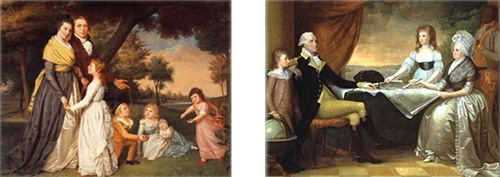
On the left: James Peale “Artist & His Family”, 1795. On the right: Edward Savage “The George Washington Family”, 1789
Colleen Atwood said, “There were no existing photographs, but since this film is not a history lesson, the work becomes very impressionistic”.
Constable’s uniform
In the film's opening scene, Johnny Depp wears a constable’s uniform, which Colleen Atwood describes as incredibly chic. “Uniforms of the period were beautifully made”, she said. “They weren't the polyester we have today”.
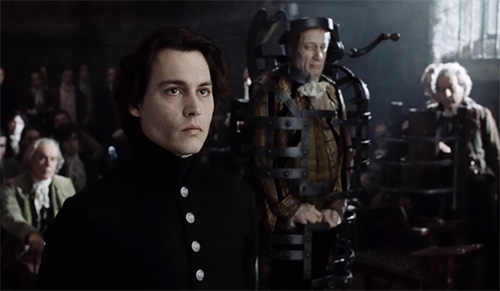
But according to IMDB, “The New York Police Department of which Ichabod Crane is a constable, was not founded until 1844, and the dark blue uniform was not issued until 1853”.
Here's an illustration of the NYPD uniform, which is fashioned after London's Metropolitan Police Service’s navy blue uniform, that came into effect in 1854. While police wore a badge, they were not required to wear a regulation uniform before this time.
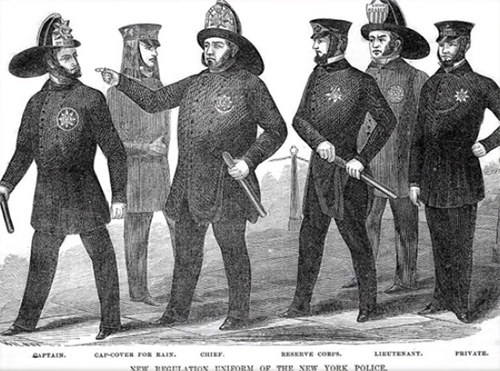
Ichabod Crane’s stage costumes
Once Ichabod travels to Sleepy Hollow, he essentially wears one costume in varying stages “– a long black waistcoat with hand-sewn gold trimming and a hand-printed silk lining that kicks back light when he moves”.
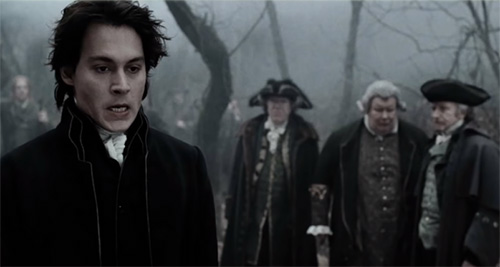
Colleen Atwood explains that “People didn't have a lot of clothing unless they were incredibly wealthy. The idea with Ichabod's costume was to make it very minimal, sleek and long in feeling, a sort of shadowy feeling of his character”.
According to IMDB, “Johnny Depp offered to add prosthetics to his face to make himself look ugly, but Director Tim Burton wanted to base the character on Crane’s more unattractive personality traits, his reported squeamishness and eccentricity”.
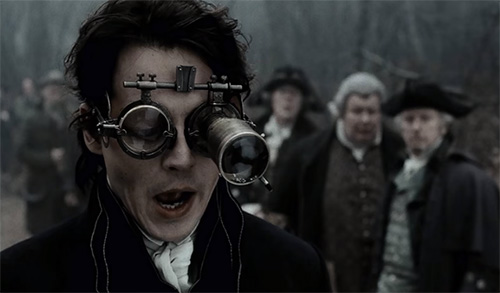
It's likely that multiple costumes were required because of the various blood splatter effects and overall dirty conditions on the “Sleepy Hollow” set.
Fun fact! The “Sleepy Hollow” movie was almost entirely shot with a blue filter, so for the blood to appear red, the liquid had to be bright orange.
As a reference, here's an example of a men’s silk & linen three-piece ensemble from The Met. This suit is French in origin and it dates from about 1790. And, like Ichabod Crane’s, this ensemble features a stand-up collar on both the waistcoat and the coat.
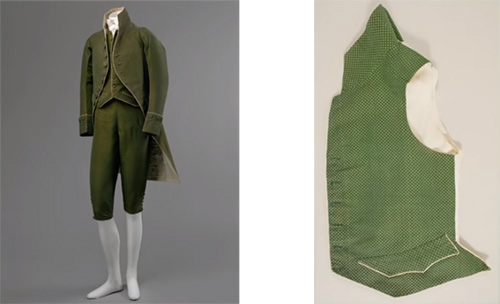
Here's another example. This is an American velvet frock coat and waistcoat and it's from a collection at the Museum of Fine Arts in Boston. It dates between 1775 to 1800.
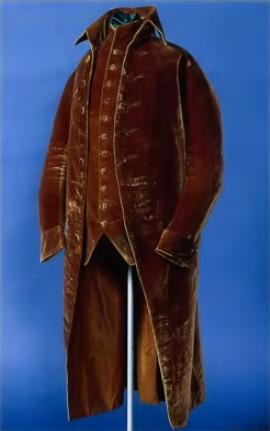
Here is a still of actor Johnny Depp in his costume and then, pictured on the right, is from an exhibit. And a nice detail is the green stoppers on his otherwise black riding boots.
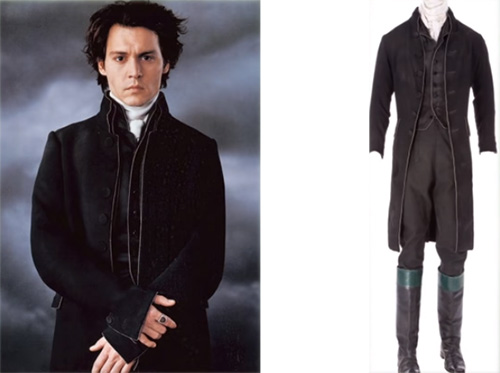
Here's an example of some French early-19th-century leather presentation riding boots from the Los Angeles County Museum of Art.
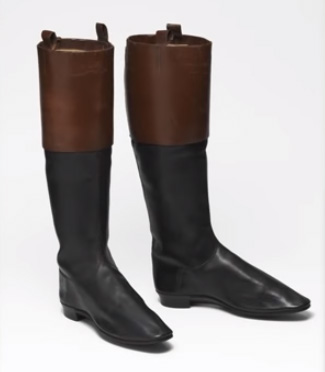
In this scene, you can see the beautiful pleats on Ichabod Crane’s poet's shirt and also a close-up of his signet ring.
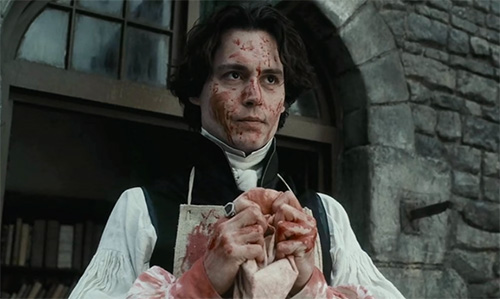
Sleepy Hollow villagers
The more elaborate costumes were worn by the villagers of Sleepy Hollow, each one intricately crafted from specially chosen fabrics.
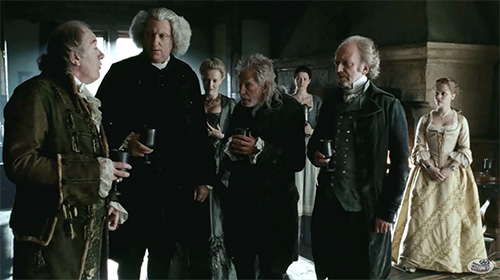
Colleen Atwood said of this, “They're sort of like country folk that are five or six years behind the minute, but with the maximum amount of trim and gear to show their money on the outside”.
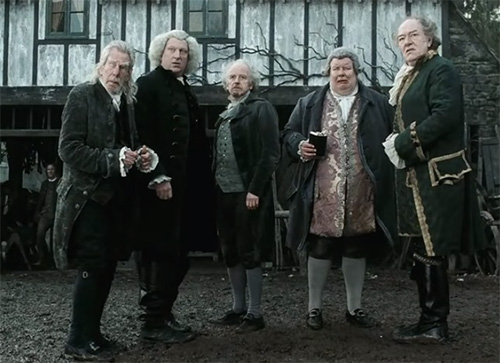
The costume designer has established each character by way of their costumes, and hair and makeup have helped in this regard as well, in a way to convey their occupation and station within the village.
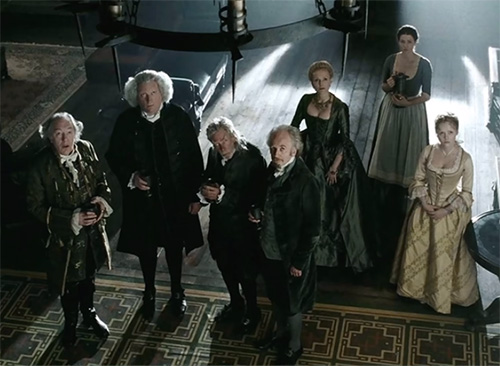
According to IMDB, “The costumes worn by Katrina and Lady Van Tassel were from an earlier decade, circa 1785. Colleen Atwood… wanted the costumes to reflect the period 1794 [despite the setting of 1799]. By 1794, women's dresses reflected the beginning of the Regency period: closer to the body with a higher waist and much less elaborate than those displayed in the film”.
Katrina Van Tassel’s stage costumes
Unlike Ichabod Crane and some of the town's folk, this Sleepy Hollow’s aunjanue has multiple costume changes. Her father Baltus Van Tassel is the wealthiest man in Sleepy Hollow and she dresses the part of his only daughter and heir.
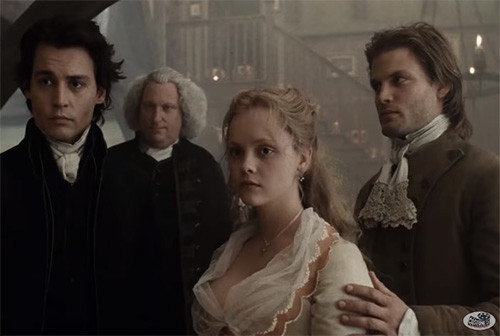
Colleen Atwood stated that, at the time, actor Christina Ricci had the perfect body for period costumes because she is tiny yet curvaceous.
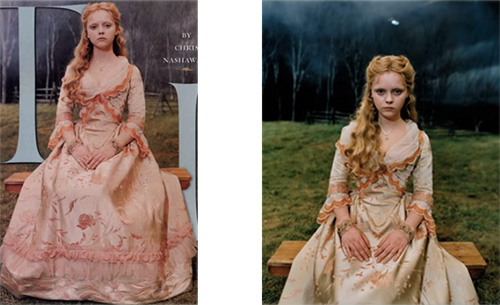
Here's the two-piece gown on display. After production was closed, many of the Sleepy Hollow costumes like this one were sold through an online auction. And this is sometimes done as a way to recoup some money, but it's a bit unfortunate because audiences often want to see the costumes and props from their favorite movies.
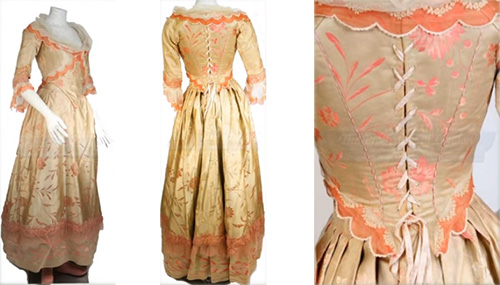
In these two late-18th-century neoclassical paintings on display from The Met, we see examples of a tucker, featured along the neckline of the bodice.
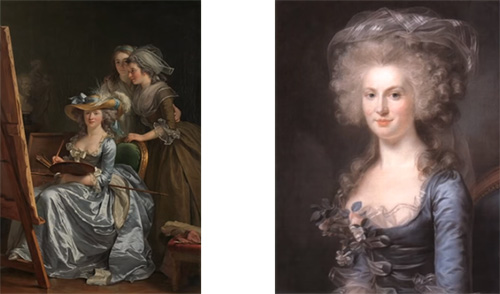
On the left: “Self-Portrait with Two Pupils”, Adelaide Labille-Guiard, 1785. On the right: “Portrait de Anne-Felicite Gresille”, Adelaide Labille-Guiard, 1785
According to the Age of Antiquity Historical Costuming blog, “A tucker is a ruffle of either lace or fine material (cotton mull or silk gauze) that is ruffled onto a tape and then sewn to the inside of a gown’s neckline so that it shows on the outside, Through most of the 18th century tuckers were relatively narrow and stuck straight up, partially filling in the low neckline”.
And you can see the tucker featured on many of Katrina's bodices. This type of bodice she's wearing here closely resembles a French caraco, meaning “camisole”.
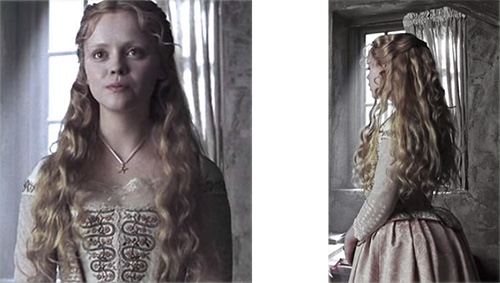
Here's an example of a late-18th-century (1790-1800) skirt and matching caraco from the City of Paris Fashion Museum.
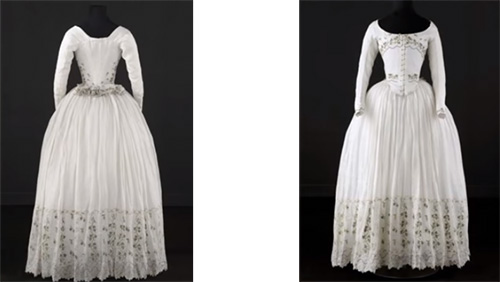
This type of jacket is sometimes referred to as a pierrot jacket – a French word for “sparrow”. So the pierrot jacket, like this one from the Kyoto Costume Institute Collection, is a short fitted jacket with short tails, which is probably why it's referred to as a sparrow. And it was popular from the mid-1780s through to the 1790s.
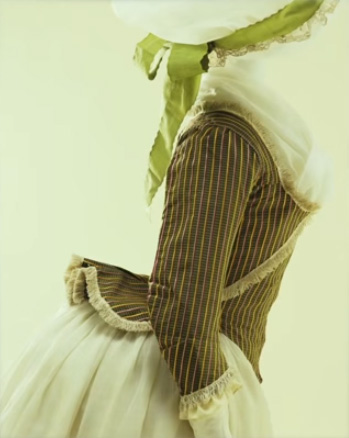
This muted blue velvet striped bodice with a center-front closure is matched beautifully with this pleated taffeta skirt. The bodice has a wide open neckline, which is trimmed with a gently gathered tucker again, and it's fastened at the center front most likely with hooks and eyes.
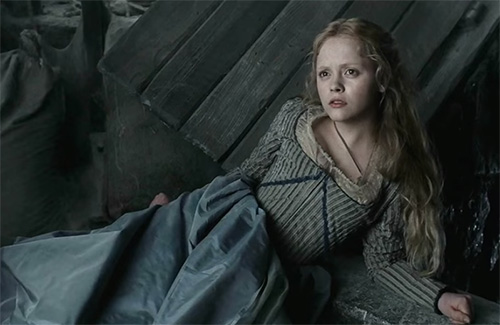
The delicate paneled apron on the front of the skirt. It was actually a popular fashion item in the late 1700s.
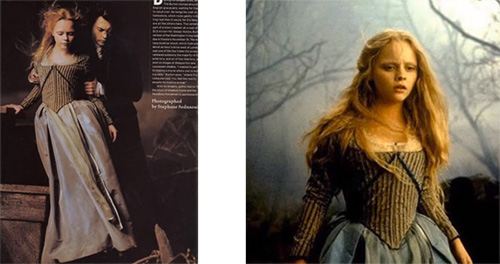
This type of gown, as seen in this painted portrait on display at the Palace of Versailles, was made popular in France by Queen Marie Antoinette. The shepherdess gown, as it was called, was directly inspired by the attire worn by countrywomen.
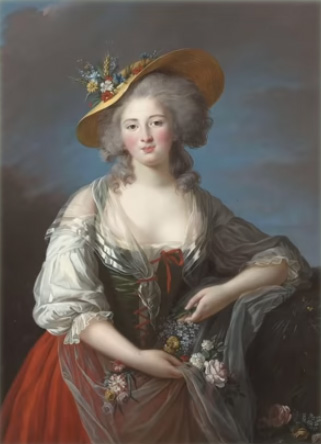
Elizabeth of France, Versailles, Madame Le Brun, 1782
Here's the costume looking much worse for wear before it was sold through an online auction. We see that without the original foundation garments that give the costumes their structure and shape, it loses some of its Hollywood magic.
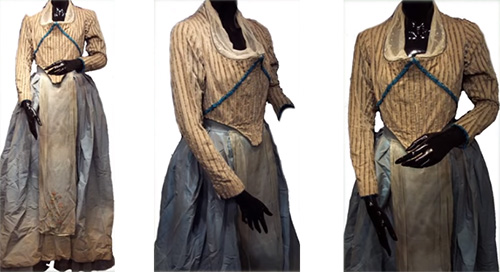
Here's a close-up detail of both the lovely embroidery on the linen apron, which you can see is really crushed, and the died machine-embroidered boots on the right.

This frock sort of blends into the masonry of the chimney and the misty landscape of Sleepy Hollow. So, the gown looks a bit like a riding habit with the overskirt drawn up at the back.
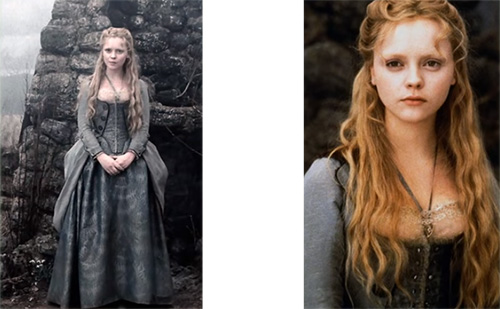
Here's a good look at the fullness of the skirt.
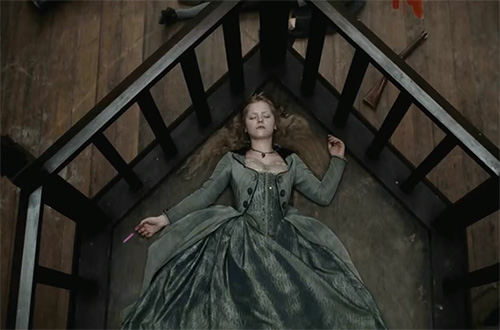
This style of costume is called a “robe a l'Anglaise” or “English gown”.
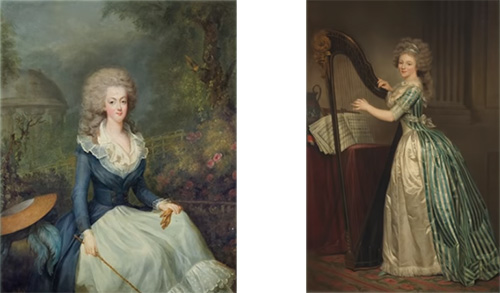
On the left: “A Portrait of Marie Antoinette”, Jean-Baptiste Andre Gautier-Dagoty, 1780. On the right: “Self-Portrait with a Harp”, Rose Adelaide Ducreux, 1791, The Met
According to the Palace of Versailles where the portrait on the left is on display, it was characterized by the rejection of panniers which were replaced by a frame that was padded using horsehair. And this type of gown was inspired by the redingote worn by men during the same period. This redingote gown was fairly versatile – always close-fitting at the waist, it was often more open at the front but also could close using large metal buttons.
Here's the costume from the online auction house again, before it was sold. Without the foundation garments that gave this skirt its fullness. And the skirts of the overgown are drawn up in a polonaise with the help of cords and then looped onto buttons at the waist.
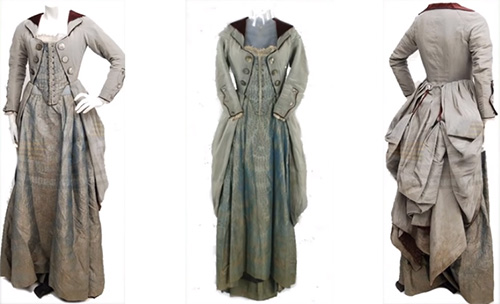
One of the most striking costumes is this stunning soft green hooded cloak with a red rose motif on the silk lining.
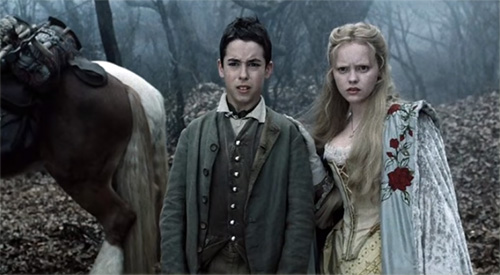
It appears to be made of panne velvet or a very low pile fur and then lined with silk or matte satin. The striking feature are those red rose embellishments. It's difficult to tell whether they are hand-painted or embroidered or even both. It might possibly be the appliques because, depending on the frame, at times, they appear to be three-dimensional.
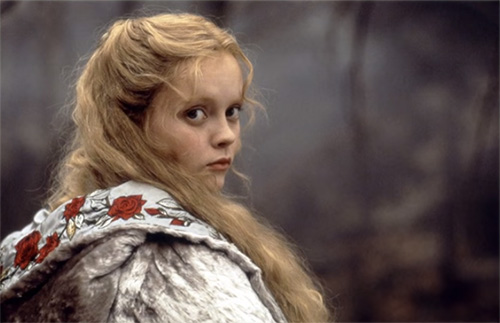
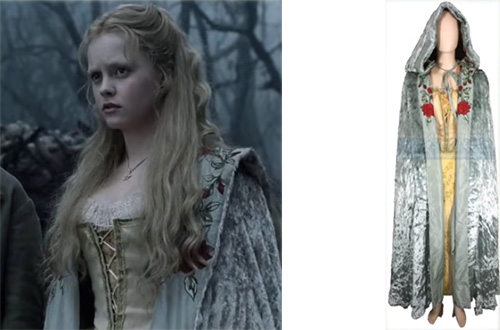
This is what Katrina is wearing underneath the cloak. The bodice is, again, that sort of shepherdess gown.
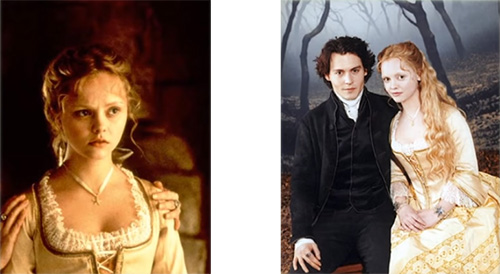
Some aspects of the silhouette, like the cuffs of the sleeves, even harken back to the mid-18th century.
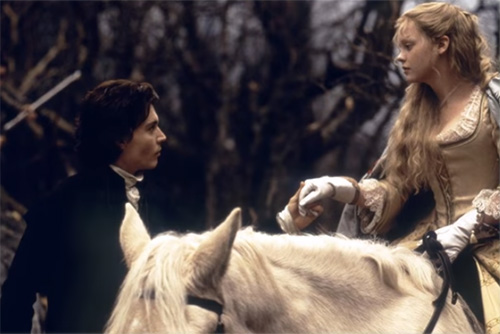
This black and white striped gown is called a “robe a la Polonaise”.
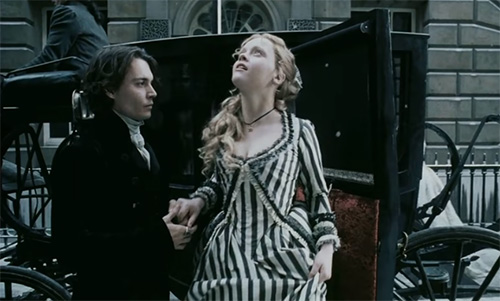
According to The Met Museum, it was a style of gown with a close-fitting bodice and the back of the skirt gathered up into three separate puff sections to reveal the petticoat below. Most often, the dress had rows of little rings sewn inside the skirt – like with this costume – through which a cord ran from hem to waist.
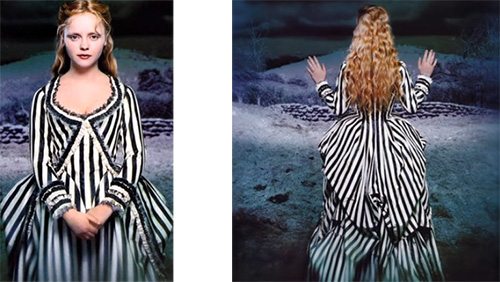
However, in some instances, the skirt was held in place by simple cord sewn to the inner waist of a dress and looped over buttons attached to the outside waistline, like we saw on her previous costume.
Here's a stunning example of a woman's gown with a similar likeness, dating 1785 to 1790. This gown is cut in the English way, without a sack back, and this tulle dress is of French origin from a collection at the Los Angeles County Museum of Art.

Here's an example of a robe a la Polonaise from The Met. This French silk gown dates about 1780.
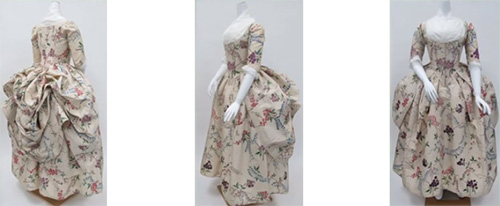
Beth Killian’s stage costumes
One of the villagers in Sleepy Hollow is the midwife Beth Killian.
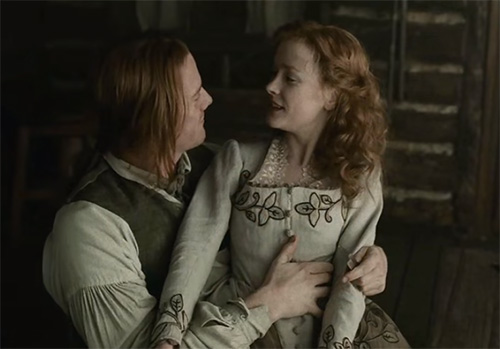
Here, she’s dressed in a hand-embroidered linen bodice and skirt with a beautiful bobbin lace tucker.
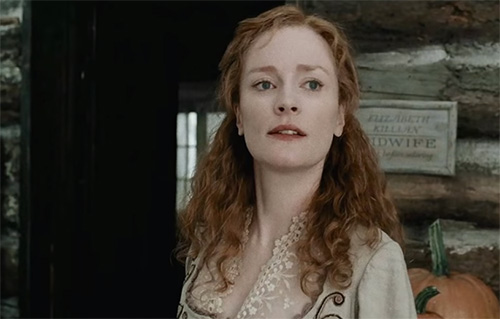
The collar, cuffs, and hem are also trimmed with the pretty scalloped lace. The bodice features this exaggerated conical shape that drops deeply in the front but is softened by these pretty flounces at the side waist. And then, the bodice is closed at the front with these crochet-lace-covered buttons.
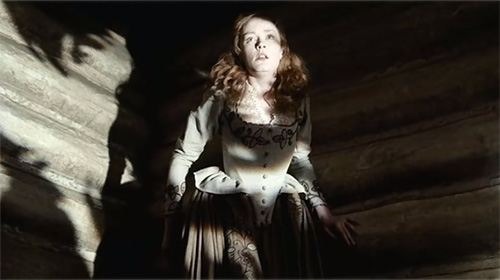
Here's the costume on display before it was sold to a private collector. While it looks as though there is a built-in crinoline, the costume lacks the stays and bum roll that give a costume like this its silhouette.
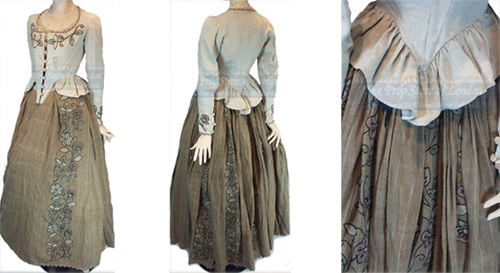
Lady Mary Van Tassel
Next to Katrina, Lady Mary Van Tassel has some of the most stunning costumes in Sleepy Hollow.
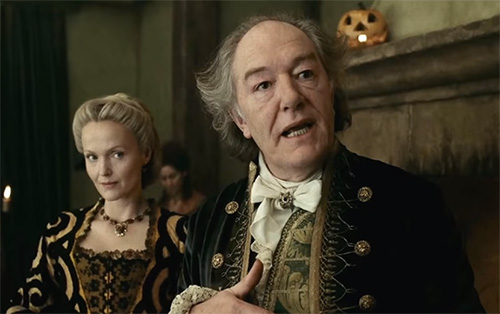
Colleen Atwood said, “She's definitely ruling the roost. When a character aspires to something greater than what they've had, they take it to a whole different level”.
This gown’s a complicated bit of business. The dress is made from the sunny-yellow silk jacquard with this sheer net overlay, featuring this black swirled detail. It appears that the swirls are created with strips of black taffeta that were pleated or ruched on both sides and then tacked down into position. This is a commonly used decorative technique done in women's 18th and 19th-century gowns.
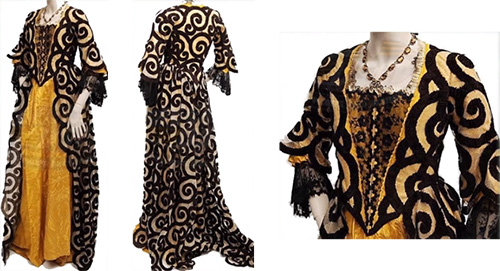
Here's an example of the ruching technique taken from the Antique Sewist blog. Its purpose is twofold – firstly, it creates a beautifully decorative trim, while at the same time, the gathers or the pleats make it easier for the trim to go around curves like we see here.
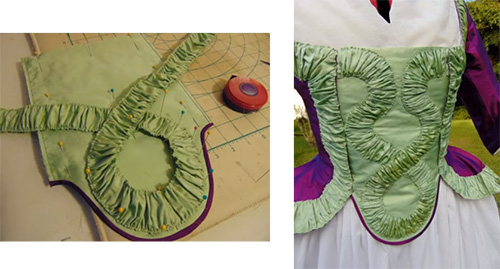
This English-style taffeta gown would typically be fastened with pins at the front, but instead, it appears that the stomacher is split and closed at the center front with hooks and eyes.
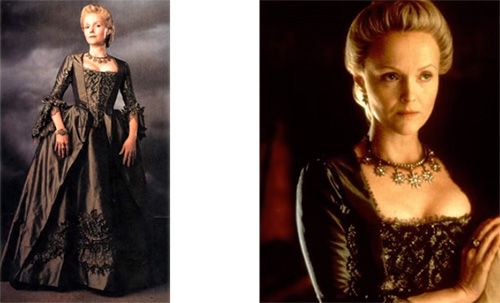
Here's an example of a silken metal robe a l'Anglaise, 1770-1775.
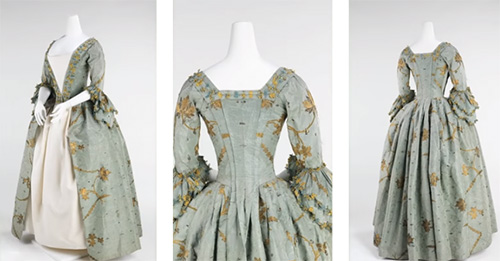
According to The Met where this beauty is on display, the robe a l'Anglaise developed with a fitted back after the style of dress worn in England. The silhouette is composed of a funnel-shaped bust feeding into wide rectangular skirts, which were often opened at the front to expose a highly-decorated underskirt.
During this scene, lady Mary has removed her overgown revealing this stunning set of stays underneath. The bone channels here are embellished with this pretty embroidery stitch. A linen shift would always be worn under the stays but for the purpose of this scene and perhaps to give the character a more seductive look, the shift was omitted.
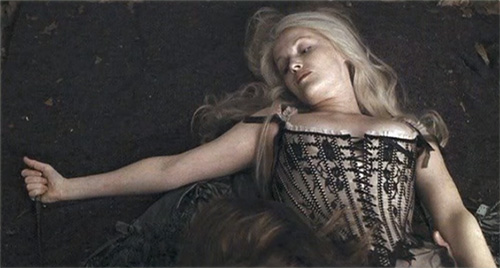
Here's an example of a set of stays from a slightly earlier time period. These silk-covered stays of Italian origin are from the 1770s and, according to The Met, whalebone was replaced by steel boning, which only increased the strength of corsets and aided the ability to draw in the laces even tighter.
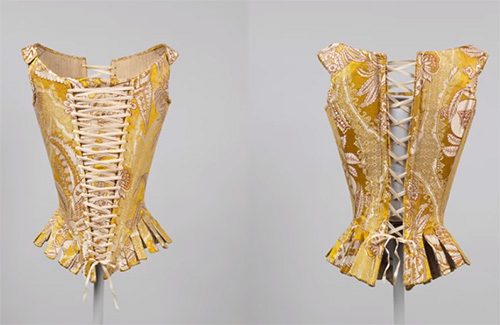
In this less formal scene, lady Mary dons a caraco, which is a long-length jacket with a fitted back.
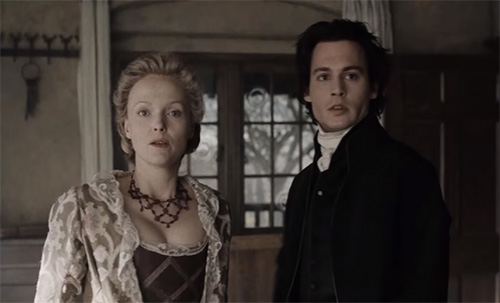
Here's another example of a caraco from the Fashion Museum of the City of Paris. This style of jacket was often worn with a petticoat and open in the front and with a stomacher or a decorative stays. And the sleeves were either full-length or 3/4 length but were always tightly fitted.
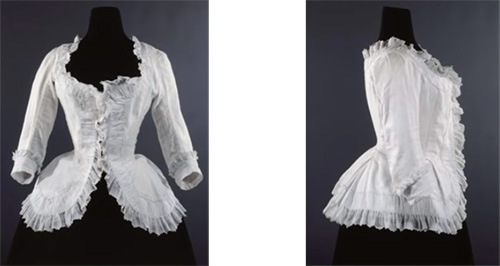
Here's the costume on display from the online auction house. The jacket and skirt are both made from an embroidered silk taffeta. And then there's a floral mesh overlay on part of the jacket and skirt. And then some of the floral motif has been cut out of the overlay and applied directly onto the center-front opening and hem of the caraco jacket.
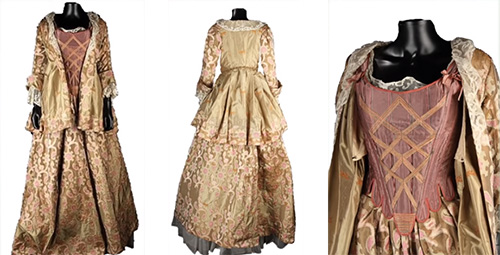
We only get a brief glimpse at this royal blue velvet gown. It has a bit of a Renaissance feel to it.
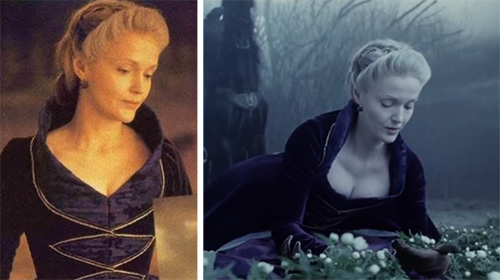
This might be the lady Mary’s best costume. It’s a brocade gown with a contrasting yellow stand-up collar and stomacher. And again, there's a little bit of a Renaissance influence with the black lace partlet.
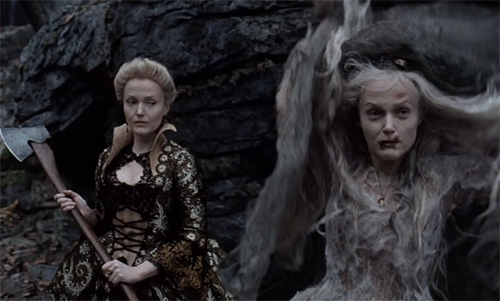
The collar and cuffs are trimmed with these embroidered daisy circles.
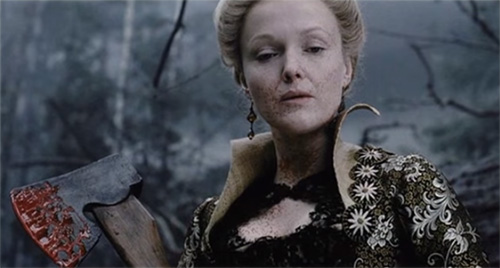
Here's a complete costume on the left, featuring this really unusual apron that's made from the same embroidered daisy circles. And then on the right, is how it looked in “Sleepy Hollow”. And you can really see how the petticoat and pannier fill out the underskirts and polonaise. And you might also notice that the yellow stomacher is positioned incorrectly on the display – it should actually be directly under the laces.
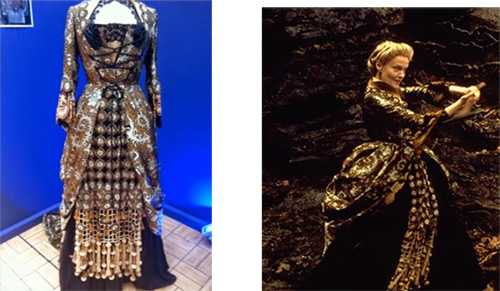
And here's the costume on another display, again from the online auction house, but without the underskirt and apron. And in the center image, you can see that the daisy circles are used to hold up the polonaise.
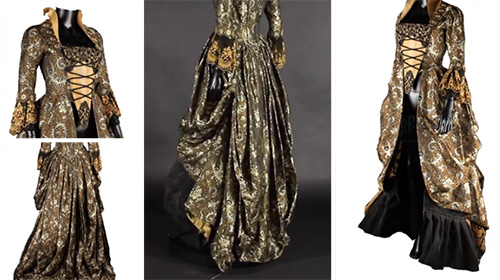
Colleen Atwood stated that this costume was the biggest challenge for her. “The biggest challenge was the black-and-white dress worn by Miranda Richardson when she goes into the Tree of the Dead, and I got the inspiration for it from a painting”, she says. “In the end, I made it my tribute to Adrian's black-and-white ball scene in the [1939] vintage film Marie Antoinette”.
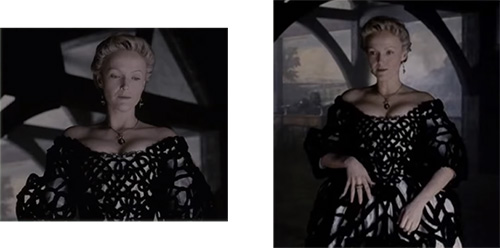
And here's the dress she is referring to. Although, that pattern looks more like her bumblebee yellow dress we first see her in.
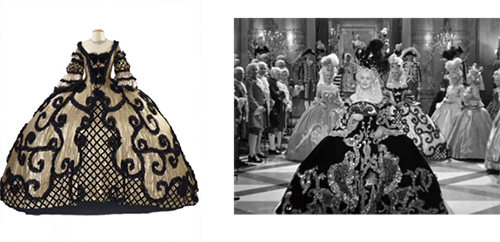
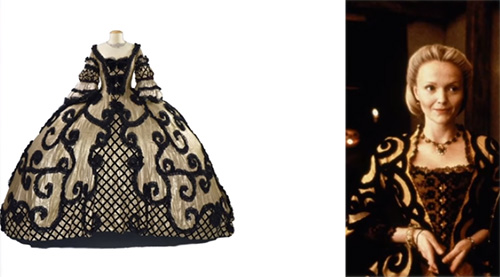
Colleen Atwood said, “It was such a challenge to create, and the way Miranda Richardson wore the costume was fantastic. The original inspiration was that it reminded me of bark in the forest. I wanted it to fit in the woods, but still be very grand and of her own world”.
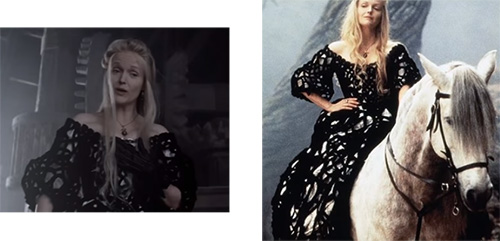
“Miranda really understood what the architecture of the dress was, that it went from light to dark. When she walked in it, she walked straight forward and then turned to the side, so you got the play of light on the costume”, the costume designer adds.

These are likely the paintings that inspired the architectural aspects of the dress. The painting of the left, by English artist Sir Edward Coley Burne-Jones is a portrait of a fictional character named Sidonia von Bork, who is the central figure in Gothic romance “Sidonia the Sorceress”. The novel is set in 16th-century Pomerania and chronicles the crimes of the evil Sidonia, whose beauty captivates all who see her. According to the Tate Gallery where the painting is displayed, the costumes actually derived from the “Isabella d'Este”, a portrait seen on the right, and it's part of the Royal Collection in Windsor.
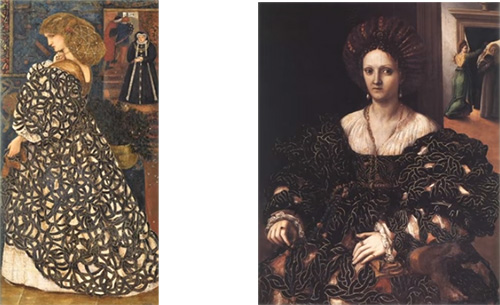
On the left: “Sidonia von Bork”, 1560. On the right: “Portrait of Isabella d'Este”, 1531
The Headless Horseman’s costume
No Sleepy Hollow story would be complete without its Headless Horseman.
According to IMDB, this is the first adaptation of The Legend of Sleepy Hollow that doesn't involve the actor playing the Headless Horseman having to conceal his head in the cloak. The head of the actor was covered with a blue mask that was deleted by means of computer graphics. The collar was also created to match the flow of the robe.
And to give actor Christopher Walken a supernatural look, he wore false teeth and ice-blue contact lenses.
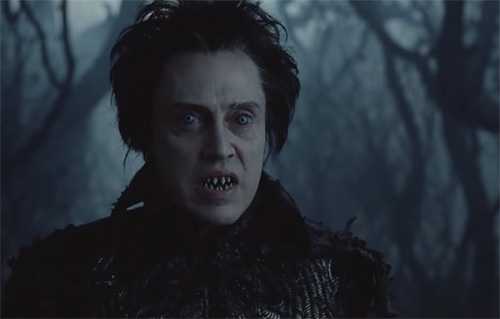
This costume looks like the doublet, which is seen in the middle. It is made of leather with an embossed leather plastron added on that features these mirroring fiery dragons. And the cloak is probably brocade, although it looks like it has been stiffened, and then it's lined with a dark-red taffeta. And the entire costume is heavily broken-down.
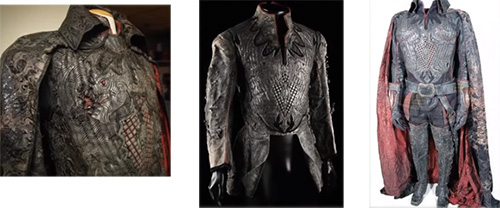
In this shot, we can see the thigh-high side-laced boots made of leather with a red backing and featuring spurs, and then gauntlets that feature some type of battle axe. And finally the cloak, which is in the picture on the right, appears heavily distressed but it must be quite heavy because it's worn on the body with leather straps.
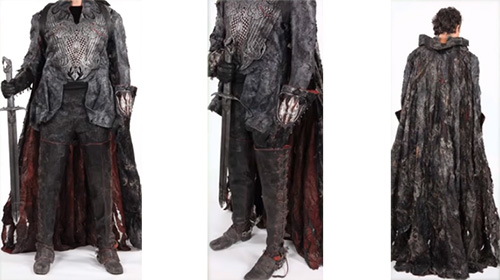
(c)


